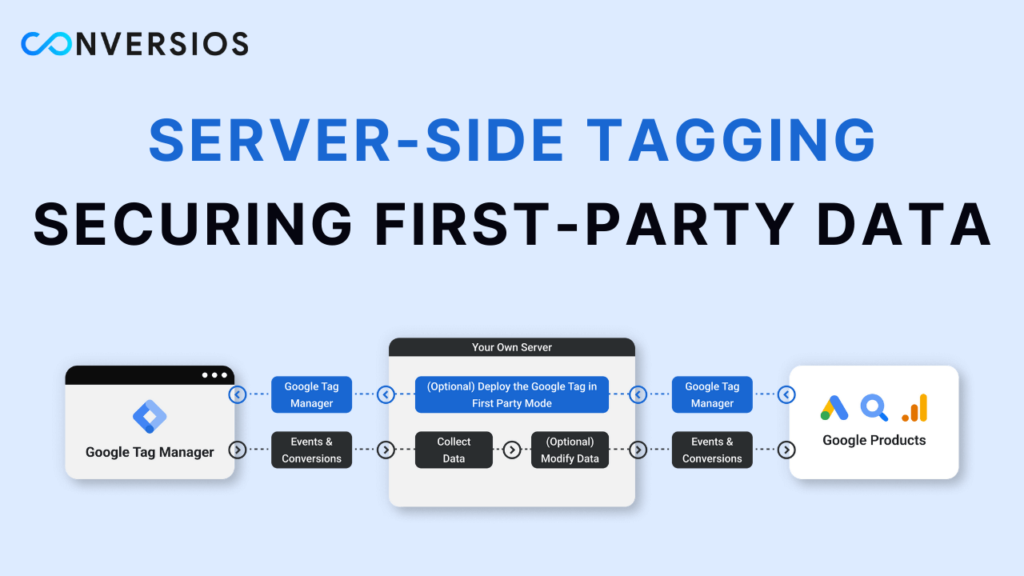As online privacy rules tighten, businesses need smarter ways to track customer behavior while respecting privacy laws like GDPR and CCPA.
That’s where First-Party Data comes in—it’s the data you collect directly from your customers, like sign-ups, purchases, or browsing history.
But collecting data isn’t enough. It would help if you also processed it securely. This is where server-side tagging can help keep your data safe while ensuring accurate tracking—even if ad blockers or cookie restrictions are in place.
Let’s break down how First-Party Data and Server-Side Tagging work together and why they’re a must for any business wanting better marketing performance and privacy compliance.
What Is First-Party Data?
First-party data is information you collect directly from your customers through:
- Websites (e.g., purchases and form sign-ups)
- Mobile Apps (e.g., app usage and in-app purchases)
- Email Campaigns (e.g., clicks and opens)
Since this data comes directly from your audience, it’s accurate, reliable, and privacy-compliant. Unlike third-party data, you own it and can use it however you choose (as long as users give consent).
To ensure secure processing, it’s essential to set up a server-side container. Learn how to create a server-side container in Google Tag Manager to enhance your data collection strategy.
Why Use Server-Side Tagging with First-Party Data?
While collecting First-Party Data is essential, processing it securely is just as important. Server-side tagging helps by sending data directly from your server, bypassing ad blockers and privacy restrictions.
Key Benefits:
- Keep Data Secure: Your data stays on your server, reducing the risk of leaks.
- Better Tracking Accuracy: Ad blockers won’t block your data because requests are sent from your server.
- Own Your Data: You control what gets shared and with whom.
- Stay Legal: Server-side tagging helps businesses comply with privacy laws like GDPR and CCPA by securing user data and ensuring transparency.
Explore how Google Consent Mode helps with privacy compliance to learn how it streamlines data permissions and consent management.
How Server-Side Tagging Improves Your Marketing?
1. Secure Data Collection
Your customer data goes directly from your website or app to your secure server before being sent to platforms like Google Analytics or Facebook Ads. This prevents data leaks and keeps sensitive information safe.
For more technical details, you can read the official Google guide on server-side tagging to explore implementation steps.
2. Track Ads Accurately
When users block cookies or use privacy-focused browsers, they might lose important customer data. But with Server-Side Tagging, data gets collected directly from your server, ensuring nothing is missed.
3. Personalize Campaigns
You can create custom data filters, sending only relevant customer information to your marketing platforms. This means better-targeted campaigns and higher return on investment (ROI).
4. Improve Sales Tracking
Since data is more accurate, you’ll get better insights into how customers behave, which campaigns drive sales, and how to improve performance.
Who Can Benefit from This Setup?
1. E-commerce Stores
- Track purchases, abandoned carts, and product page views. Mastering Facebook Pixel for E-commerce: Conversion Tracking Guide to gain better visibility into customer behavior.
- Offer personalized deals based on shopping history.
2. SaaS Businesses
- Monitor trial sign-ups, product feature usage, and renewals.
3. Lead Generation Websites
- Collect and process customer leads securely while sending follow-up campaigns based on user actions.
Real-Life Example: Fitness Platform Success Story
Imagine a fitness platform that tracks user workouts and app subscriptions. By combining First-Party Data collection with Server-Side Tagging, they bypass ad blockers and privacy restrictions, allowing them to track subscription renewals and workout completions. This helped boost membership renewals by 40% thanks to personalized workout plans and timely subscription reminders.
Challenges to Keep in Mind
- Tech Setup Can Be Tricky: Setting up a server-side system may require technical expertise. Consider hiring a web developer or using a managed service.
- Hosting Costs: You may need cloud hosting, which adds extra costs.
- Privacy Audits: Stay compliant with privacy laws by regularly reviewing your data practices. Learn more about Google Analytics data privacy practices to ensure compliance.
Final Thoughts
Combining Server-Side Tagging with First-Party Data is the best way to future-proof your marketing while keeping customer data safe. Whether you’re running an e-commerce store, SaaS business, or lead generation site, this powerful duo helps you track accurately, improve campaign results, and stay legally compliant in today’s privacy-first digital world.
Frequently Asked Questions
Q. What is first-party data and why is it important?
First-party data is information collected directly from your customers through your website, app, or email. It’s more reliable and privacy-compliant compared to third-party data and gives businesses full control over usage with user consent.
Q. How does server-side tagging improve first-party data tracking?
Server-side tagging processes data on your own server, bypassing ad blockers and browser restrictions. This ensures more accurate tracking and secures user data from third-party access.
Q. Is server-side tagging GDPR and CCPA compliant?
Yes, server-side tagging supports privacy compliance by keeping user data secure, giving you control over what is shared with third-party platforms, and integrating with tools like Google Consent Mode.
Q. Who can benefit from server-side tagging and first-party data collection?
E-commerce businesses, SaaS companies, and lead generation websites benefit by tracking key user actions securely, running personalized campaigns, and ensuring compliance with data privacy regulations.
Q. What are the main benefits of using server-side tagging for marketing?
Server-side tagging ensures secure data collection, improves ad tracking accuracy, allows personalization through data filtering, and enhances sales performance with better tracking insights.
Q. Are there any challenges to implementing server-side tagging?
Yes, it may require technical setup, cloud hosting costs, and ongoing privacy audits. However, managed services or plugins like Conversios can simplify the implementation.

